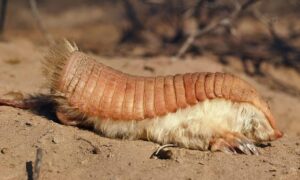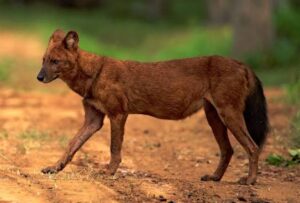Fossa: The Apex Predator of Madagascar
Introduction
On the island of Madagascar, where evolution has crafted some of the most unique creatures on Earth, one predator rules above all others. Sleek, powerful, and elusive, the fossa (Cryptoprocta ferox) is the top carnivore of this isolated ecosystem. With a body resembling a cross between a cat, a mongoose, and a small cougar, the fossa is often misunderstood and rarely seen in the wild.
Despite looking very “cat-like,” the fossa is not a feline at all—it belongs to the Eupleridae, a family of carnivorous mammals found only in Madagascar and closely related to mongooses. As the apex predator of the island, it plays an essential ecological role by regulating lemur populations and maintaining balance in Madagascar’s fragile forests.
In this article, we’ll explore the fascinating biology, behavior, and significance of the fossa, tracing its discovery, anatomy, hunting strategies, cultural perceptions, and conservation challenges.
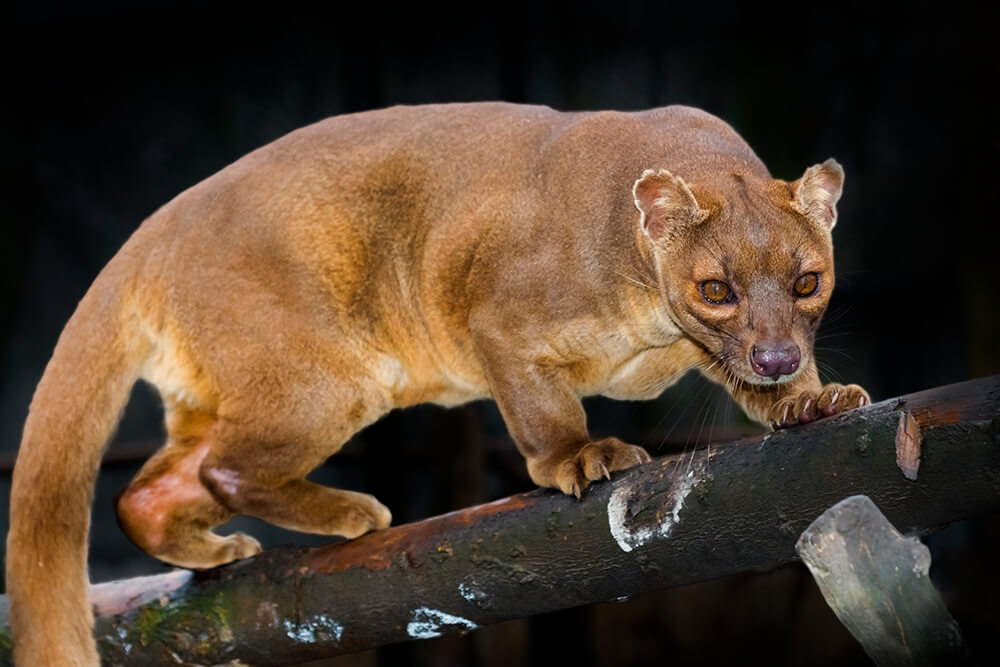
The Name and Early Discovery
The name “fossa” comes from Malagasy, the local language of Madagascar, and is pronounced “FOO-sah” in most regions of the island, though in some dialects it’s “FOOSH.” The scientific name, Cryptoprocta ferox, reflects its mysterious nature:
- Crypto = hidden
- Procta = anus (referring to its concealed anal glands, used for scent marking)
- Ferox = fierce
Early European naturalists who visited Madagascar in the 18th and 19th centuries were puzzled by this animal. Its long body, retractable claws, and cat-like movements suggested it might be a type of wild feline. Others compared it to civets or mongooses. It wasn’t until genetic studies in the late 20th century that scientists confirmed its place within the mongoose lineage.
The fossa’s taxonomic confusion mirrors the complexity of Madagascar’s biodiversity—a world apart from Africa, where familiar categories don’t always apply.
Size and Physical Description
Fossas are the largest carnivorous mammals native to Madagascar. Though small compared to big cats, they are formidable hunters within their ecosystem.
- Length (head and body): 70–80 cm (27–31 inches)
- Tail length: 65–70 cm (25–28 inches), nearly as long as the body
- Weight: 5.5–8.5 kg (12–19 lbs), with males larger than females
- Shoulder height: About 35 cm (14 inches)
Distinctive Features
- Cat-like body: Sleek, muscular, with flexible spine and limbs adapted for climbing.
- Tail: Long and thick, providing balance in the trees.
- Claws: Semi-retractable, used for gripping bark and subduing prey.
- Head: Rounded ears, short muzzle, and sharp carnassial teeth for slicing flesh.
- Fur: Short, dense, and reddish-brown to dark chocolate in color, with paler underparts.
- Eyes: Large, golden-brown, adapted for both day and night vision.
The combination of feline grace and mongoose lineage makes the fossa one of evolution’s most unique predators.
Classification and Evolutionary Background
The fossa belongs to the family Eupleridae, a group of carnivores found only in Madagascar. This family also includes smaller species like the Malagasy civet, fanaloka, and various mongooses.
Evolutionary Story
- Around 20–25 million years ago, a small ancestor related to mongooses rafted to Madagascar from mainland Africa, likely during a storm or flood event.
- Isolated on the island, this ancestor diversified into several carnivorous species, with the fossa evolving into the largest and most specialized predator.
- Today, the fossa represents a rare case of convergent evolution, developing cat-like features despite being more closely related to mongooses than to felines.
Its unique evolutionary path has made the fossa a top predator in a land without big cats, wolves, or hyenas.
Habitat and Distribution
The fossa is found only in Madagascar, making it endemic to the island.
Range
- Distributed across much of Madagascar, from humid rainforests in the east to dry deciduous forests and spiny deserts in the west and south.
- More common in protected areas like Kirindy Forest, Ranomafana National Park, and Ankarafantsika Reserve.
Preferred Habitat
- Dense forests with abundant lemur populations.
- Requires both trees and open ground for hunting, as it is equally skilled at climbing and running.
- Fossas are often territorial, with home ranges that can span several square kilometers.
Diet and Hunting Strategies
Fossas are carnivores with a highly varied diet.
Primary Prey
- Lemurs: Up to 50% of their diet. Fossas are the only predators capable of consistently hunting medium-sized lemurs like sifakas and brown lemurs.
- Other prey: Rodents, birds, reptiles, amphibians, tenrecs, and even livestock (chickens and small goats) near villages.
Hunting Style
- Arboreal and terrestrial hunter: Fossas can chase lemurs through treetops with astonishing agility. Their long tails act as counterbalances as they leap between branches.
- Stealth and power: They stalk quietly, then pounce with explosive speed.
- Killing bite: Like cats, they deliver a powerful bite to the neck.
Their ability to hunt both in trees and on the ground makes them unmatched in Madagascar’s predator hierarchy.
Behavior and Lifestyle
Activity Patterns
- Cathemeral: Active both day and night, depending on prey availability.
- Solitary: Fossas usually live and hunt alone, except during mating season.
Social Behavior
- Territorial: Males maintain large ranges overlapping with several females.
- Scent marking: They use glands near the anus, chest, and mouth to mark trees and rocks, signaling territory and reproductive status.
Reproduction
- Breeding season: October–December.
- Courtship: Unique and dramatic—females choose tree platforms where multiple males compete for access, sometimes forming a mating queue.
- Gestation: ~90 days.
- Litter size: 2–4 pups, born blind and helpless.
- Development: Pups open eyes at 2–3 weeks, weaned at 4–5 months, and remain dependent for over a year.
Interestingly, young fossas undergo temporary masculinization—female juveniles initially resemble males, which may help avoid harassment until they reach maturity.
Lifespan
- In the wild: ~15 years
- In captivity: Up to 20 years
Ecosystem Role
As Madagascar’s apex predator, the fossa is vital to the balance of its ecosystems.
- Controls lemur populations: Prevents overgrazing of trees by herbivorous primates.
- Regulates smaller species: Keeps rodent and bird numbers in check.
- Promotes biodiversity: By influencing prey behavior, it creates a healthier balance of species in the forest.
Without the fossa, Madagascar’s delicate ecological web would face severe disruption.
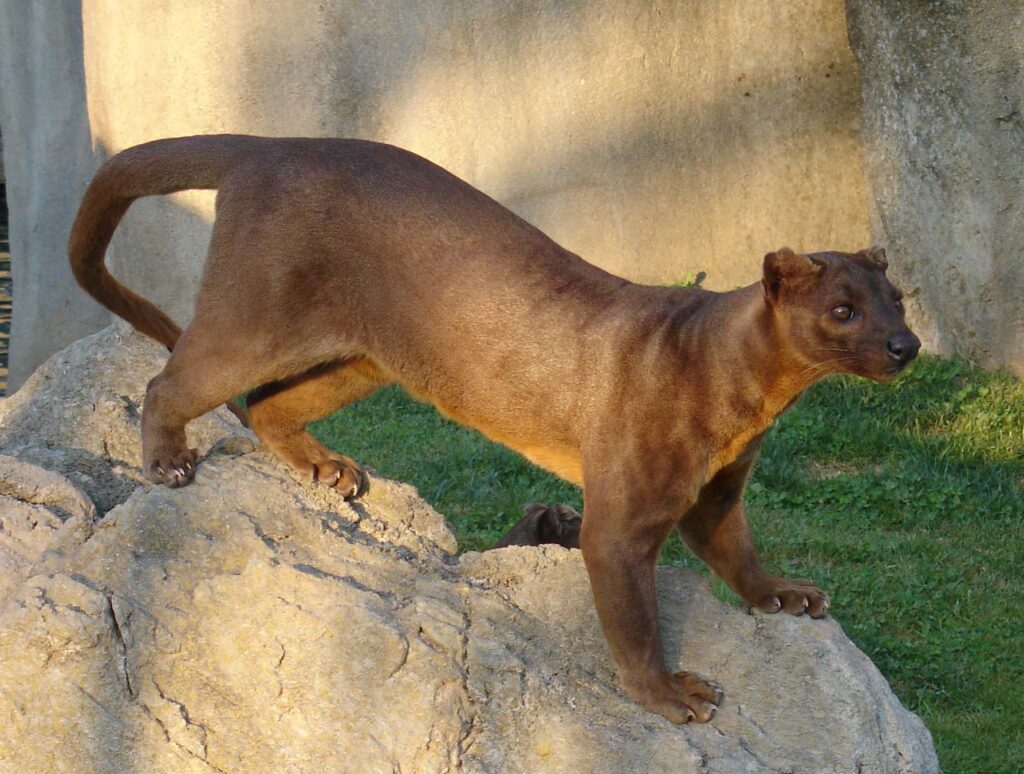
Threats and Conservation
The fossa is currently listed as Vulnerable by the IUCN. Its population is estimated at fewer than 2,500 mature individuals, and numbers are declining.
Major Threats
- Habitat Loss
- Madagascar loses about 1% of its forest cover annually due to logging, slash-and-burn agriculture, and charcoal production.
- Fragmentation isolates populations, making reproduction and genetic diversity harder to maintain.
- Human Conflict
- Fossas occasionally prey on chickens and small livestock, leading villagers to hunt or poison them in retaliation.
- Hunting and Trapping
- In some regions, they are hunted for bushmeat or killed because of cultural fear.
- Small Population Size
- Limited genetic diversity increases vulnerability to disease and environmental changes.
Conservation Efforts
- Protected Areas: National parks like Ranomafana and Kirindy safeguard crucial habitats.
- Community Education: Programs teaching locals about the ecological value of fossas help reduce conflict.
- Ecotourism: Responsible wildlife tourism provides incentives to protect habitats.
- Research: Long-term studies continue to improve knowledge of fossa ecology and reproduction.
Despite challenges, increased awareness is slowly improving the fossa’s chances of survival.
Cultural Impact and Folklore
In Malagasy culture, the fossa is both feared and respected.
- Fearsome reputation: Many villagers believe fossas steal babies or bring bad luck, leading to persecution.
- Folklore: Some legends describe the fossa as a shape-shifting spirit of the forest.
- Modern media: The fossa gained global attention through the animated film Madagascar (2005), where it was depicted (albeit inaccurately) as a vicious lemur-hunting villain.
While popular culture has spread awareness, it has also reinforced misconceptions, making conservation education even more important.
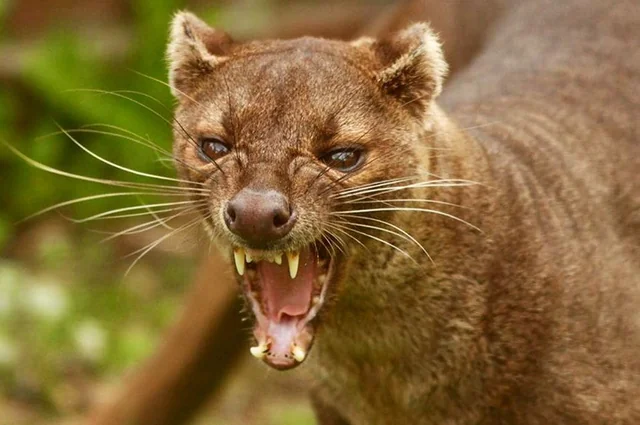
Summary: Facts at a Glance
| Attribute | Details |
|---|---|
| Name | Fossa (Cryptoprocta ferox) |
| Nickname | “Madagascar’s top predator” |
| Length | 70–80 cm (27–31 in) |
| Tail Length | 65–70 cm (25–28 in) |
| Weight | 5.5–8.5 kg (12–19 lbs) |
| Diet | Carnivorous – lemurs, birds, rodents, reptiles |
| Activity | Cathemeral (active day and night) |
| Reproduction | 2–4 pups after 90 days gestation |
| Habitat | Rainforests, dry forests, spiny deserts |
| Range | Endemic to Madagascar |
| Lifespan | 15 years (wild), 20 years (captivity) |
| Conservation Status | Vulnerable (IUCN) |
| Distinctive Traits | Cat-like predator, long balancing tail, semi-retractable claws |
| Closest Relatives | Mongooses (family Eupleridae) |
Final Thoughts
The fossa is a striking example of Madagascar’s evolutionary wonders—a predator that looks like a cat but is genetically a mongoose, adapted to fill the island’s top carnivore niche. Its agility, hunting prowess, and role in regulating lemur populations make it indispensable to the health of Madagascar’s forests.
Yet, like many of Madagascar’s unique animals, the fossa faces an uncertain future. Habitat destruction, human conflict, and limited numbers threaten its survival. Protecting the fossa means protecting Madagascar’s ecosystems as a whole.
By shifting perceptions—transforming fear into respect and fascination—conservationists hope that the fossa will not only endure but continue to reign as the guardian of Madagascar’s forests for centuries to come.

